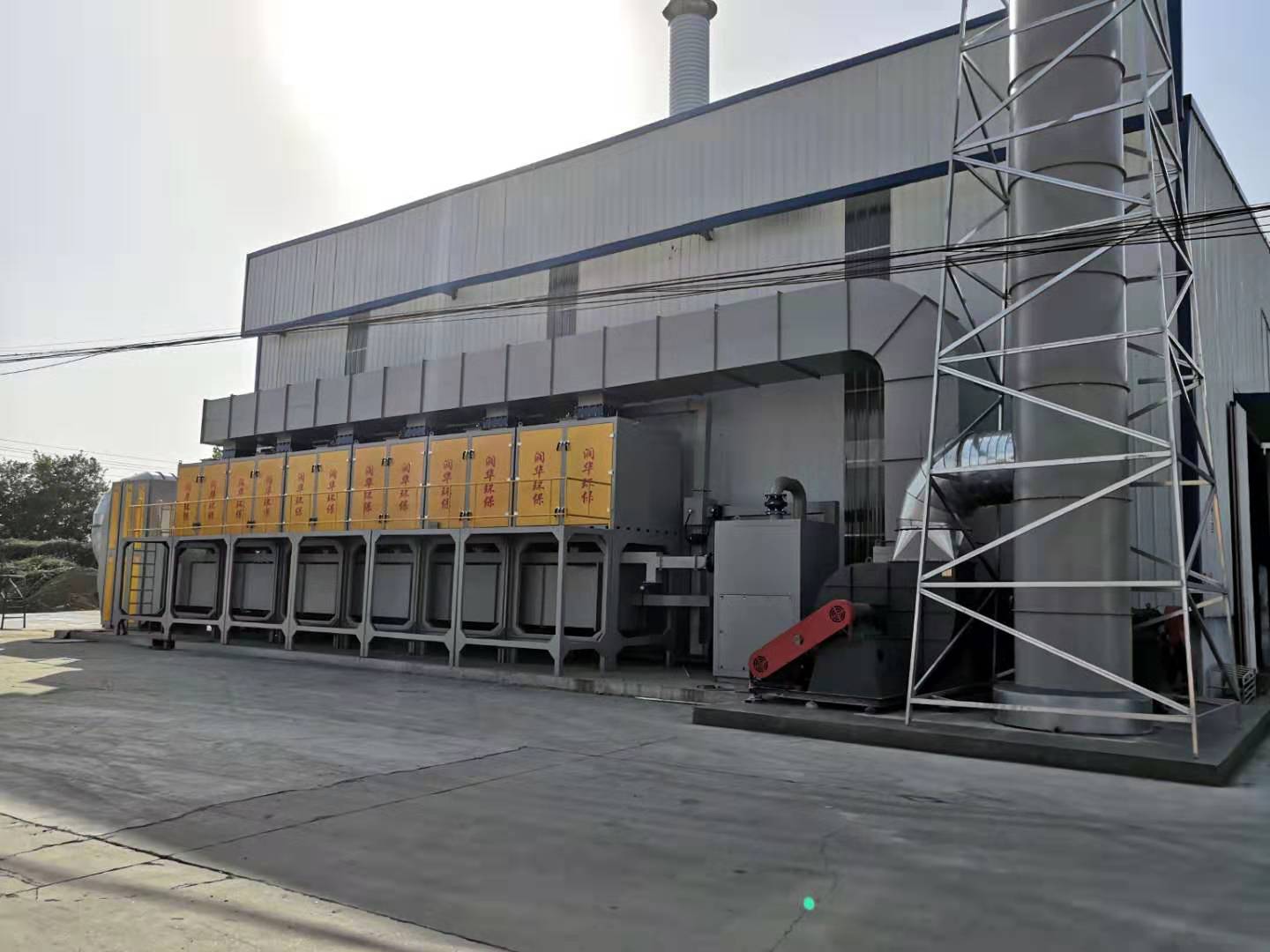含有有机物的废气在风机的作用下通过活性炭吸附层,有机物被活性炭独特的作用力拦截,清洁气体排出;一段时间后,当活性炭达到饱和时,吸附停止,有机物已经浓缩在活性炭中。
The exhaust gas containing organic matter passes through the activated carbon adsorption layer under the action of the fan, and the organic matter is intercepted by the unique force of the activated carbon, resulting in the discharge of clean gas; After a period of time, when the activated carbon reaches saturation, adsorption stops and the organic matter has been concentrated in the activated carbon.
催化净化装置内设有加热室,加热装置开始进入内循环。当热脱附气体进入活性炭箱,活性炭层温度上升到有机物沸点时,有机物从活性炭中跑出,进入催化室催化分解成CO2和H2O,同时释放能量。释放的能量用于进入吸附床进行脱附。此时,加热装置完全停止工作,有机废气在催化燃烧室中保持自燃,尾气再生循环,直有机物与活性炭完全分离并在催化室中分解。活性炭再生,有机物催化分解处理。
The catalytic purification device is equipped with a heating chamber, and the heating device begins to enter the internal circulation. When the thermal desorption gas enters the activated carbon box and the temperature of the activated carbon layer rises to the boiling point of the organic matter, the organic matter escapes from the activated carbon and enters the catalytic chamber for catalytic decomposition into CO2 and H2O, while releasing energy. The released energy is used to enter the adsorption bed for desorption. At this point, the heating device completely stops working, and the organic waste gas maintains spontaneous combustion in the catalytic combustion chamber. The exhaust gas is regenerated and circulated until the organic matter is completely separated from the activated carbon and decomposed in the catalytic chamber. Activated carbon regeneration, organic matter catalytic decomposition treatment.
3.技术性能和特点:
3. Technical performance and characteristics:
a、该设备设计原理,材料独特,性能稳定,操作简单,可靠,无二次污染。该设备占地面积小,重量轻。吸附床采用切砖结构,便于装载,易于更换。

a. The equipment has advanced design principles, unique materials, stable performance, simple operation, safety and reliability, and no secondary pollution. This device occupies a small area and is lightweight. The adsorption bed adopts a brick cutting structure, which is easy to load and replace.
b、采用蜂窝状活性炭,具有热力学性能优越、阻力低、消耗低、吸附率高等特点。与粒状(棒状)相比,非常适合在大风量下使用。
b. Adopting high-efficiency honeycomb activated carbon, it has the characteristics of superior thermodynamic performance, low resistance, low consumption, and high adsorption rate. Compared to granular (rod-shaped), it is very suitable for use in high air volume.
c、催化燃烧室采用陶瓷蜂窝体贵金属催化剂,阻力小,配低压风机能正常运行,不仅耗电少,而且噪音低。
c. The catalytic combustion chamber adopts a ceramic honeycomb precious metal catalyst with low resistance, and can operate normally with a low-pressure fan. It not only consumes less electricity but also has low noise.
d、催化燃烧装置的风量约为废气源风量的十分之一(具体根据浓度计算),加热功率维持2小时左右,节约能源。
d. The air volume of the catalytic combustion device is about one tenth of the air volume of the waste gas source (calculated based on concentration), and the heating power is maintained for about 2 hours to save energy.
e、吸附有机废气的活性炭床可以利用废气催化燃烧处理产生的热量预热冷空气进行脱附再生,脱附后的气体送入催化燃烧室净化,不需要额外的能源,运行成本低,效果显著。
e. The activated carbon bed that adsorbs organic waste gas can use the heat generated by catalytic combustion treatment of waste gas to preheat cold air for desorption regeneration. The desorbed gas is sent to the catalytic combustion chamber for purification, without the need for additional energy, with low operating costs and significant energy-saving effects.
主要核心组件A.活性炭吸附箱:吸附箱内安装活性炭层和气流分布器,对有机气体进行浓缩净化,是整个装置吸附浓缩环节的主要组成部分和核心工艺。活性炭采用无烟煤为原料,呈蜂窝状。其主要特点是:强度高、吸附速度快、吸附容量高、比表面积大、椰壳活性炭和木质活性炭之间的孔结构和孔径发达。B.催化燃烧装置:结构原理说明:催化燃烧:以催化剂为中间体,在较低温度下,有机气体可以转化为无害的水和二氧化碳气体,即:脱附后的高浓度有机气体由风量为15000的引风机送入净化装置,通过除尘阻火器系统,然后进入换热器,再送入加热室。
Main Core Component A. Activated Carbon Adsorption Box: The adsorption box is equipped with an activated carbon layer and airflow distributor to concentrate and purify organic gases, which is the main component and core process of the entire adsorption and concentration process of the device. Activated carbon uses high-quality anthracite as raw material, in a honeycomb shape. Its main characteristics are high strength, fast adsorption speed, high adsorption capacity, large specific surface area, and well-developed pore structure and pore size between coconut shell activated carbon and wooden activated carbon. B. Catalytic combustion device: Structural principle explanation: Catalytic combustion: Using a catalyst as an intermediate, organic gases can be converted into harmless water and carbon dioxide gas at lower temperatures. That is, the high concentration organic gas after desorption is sent to the purification device by an induced draft fan with a wind volume of 15000. It first passes through the dust and flame arrester system, then enters the heat exchanger, and then enters the heating chamber.
气体通过加热装置达到燃烧反应温度,然后有机气体通过催化床分解成二氧化碳和水,再进入换热器与低温气体进行热交换,使进入的气体温度上升到反应温度。如果没有达到反应温度,加热系统可以通过自动控制系统实现补偿加热,使其完全燃烧,从而节约能源,废气有效去除率达到97%以上,符合排放标准。该装置由主机、引风机和电控柜组成。净化装置主机由热交换器、催化床、电加热元件、阻火器、除尘器和减压装置等组成。阻火器和除尘器位于进气管道上,泄压装置位于主机顶部。
The gas reaches the combustion reaction temperature through a heating device, and then the organic gas is decomposed into carbon dioxide and water through a catalytic bed. It enters a heat exchanger for heat exchange with the low-temperature gas, causing the temperature of the incoming gas to rise to the reaction temperature. If the reaction temperature is not reached, the heating system can compensate for heating through an automatic control system, allowing it to burn completely, thereby saving energy. The effective removal rate of exhaust gas reaches over 97%, which meets national emission standards. The device consists of a host, an induced draft fan, and an electrical control cabinet. The main unit of the purification device consists of a heat exchanger, catalytic bed, electric heating element, flame arrester, dust collector, and pressure reducing device. The flame arrester and dust collector are located on the intake pipeline, and the pressure relief device is located on the top of the main engine.
 地图 - 热线
地图 - 热线
 地图 - 热线
地图 - 热线

